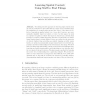143 search results - page 1 / 29 » Detecting group activities using rigidity of formation |
MM
2005
ACM
13 years 10 months ago
2005
ACM
Most work in human activity recognition is limited to relatively simple behaviors like sitting down, standing up or other dramatic posture changes. Very little has been achieved i...
GCB
2005
Springer
13 years 10 months ago
2005
Springer
Motivation: With the increasing availability of protein structures, the generation of biologically meaningful 3D patterns from the simultaneous alignment of several protein struct...
KES
2010
Springer
13 years 2 months ago
2010
Springer
Exploratory Learning Environments (ELEs) allow learners to approach a problem in different ways; they are particularly suitable for ill-defined problems where knowledge is less str...
AIED
2005
Springer
13 years 10 months ago
2005
Springer
An important but often neglected aspect in Computer Supported Collaborative Learning is the intelligent formation of learning groups. Until recently, support for group formation wa...
ECCV
2008
Springer
14 years 6 months ago
2008
Springer
The sliding window approach of detecting rigid objects (such as cars) is predicated on the belief that the object can be identified from the appearance in a small region around the...

